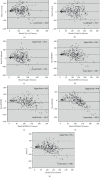The Performance of Equations That Estimate Glomerular Filtration Rate against Measured Urinary Creatinine Clearance in Critically Ill Patients
- PMID: 34055406
- PMCID: PMC8149233
- DOI: 10.1155/2021/5520653
The Performance of Equations That Estimate Glomerular Filtration Rate against Measured Urinary Creatinine Clearance in Critically Ill Patients
Abstract
The performance of glomerular filtration rate- (GFR-) estimating equations was studied against creatinine clearance measured by 24-hour urine collection (CrCl24h-urine) in critically ill patients. Methods. In this substudy of the PermiT trial (https://clinicaltrials.gov/ct2/show/ISRCTN68144998), patients from King Abdulaziz Medical City-Riyadh who had CrCl24h-urine were included. We estimated GFR using Cockroft-Gault (CG), modification of diet in renal disease study (MDRD), chronic kidney disease epidemiology collaboration (CKD-EPI), and Jelliffe equations. For the CG equation, we entered the actual weight in one calculation (CGactual-wt), and if BMI ≥30 kg/m2, we entered the ideal body weight (CGideal-wt) and the adjusted body weight (CGadjusted-wt) in two calculations. We calculated the MDRD equation based on 4 (MDRD-4) and 6 variables (MDRD-6). The performance of these equations was assessed by different ways including Spearman correlation, bias (difference between estimated GFR and CrCl24h-urine), precision (standard deviation of bias), and Bland-Altman plot analysis. Results. The cohort consisted of 237 patients (age 45 ± 20 years, males 75%, mechanically ventilated 99% with serum creatinine 101 ± 94 µmol/L and CrCl24h-urine 108 ± 69 ml/min/1.73 m2). The correlations between the different equations and CrCl24h-urine were modest (r: 0.62 to 0.79; p < 0.0001). Bias was statistically significant for CGactual-wt (21 ml/min), CGadjusted-wt (12 ml/min), and MDRD-6 (-10 ml/min) equations. Precision ranged from 46 to 54 ml/min. The sensitivity of equations to correctly classify CrCl24h-urine 30-59.9 ml/min/1.73 m2 was 17.2% for CGactual-wt, 30.0% for CGideal-wt, 31.0% for CGadjusted-wt, 31.0% for MDRD-4, 39.1% for MDRD-6, 13.8% for CKD-EPI, and 34.5% for Jelliffe equation. Conclusions. Commonly used GFR-estimating equations had limited ability to properly estimate CrCl24h-urine and to correctly classify GFR into clinically relevant ranges that usually determine dosing of medications.
Copyright © 2021 Hasan M. Al-Dorzi et al.
Conflict of interest statement
All authors declare no conflicts of interest.
Figures


References
-
- Johnson C. A., Levey A. S., Coresh J., Levin A., Lau J., Eknoyan G. Clinical practice guidelines for chronic kidney disease in adults: part I. definition, disease stages, evaluation, treatment, and risk factors. American Family Physician. 2004;70(5):869–876. - PubMed
LinkOut - more resources
Full Text Sources
Other Literature Sources

